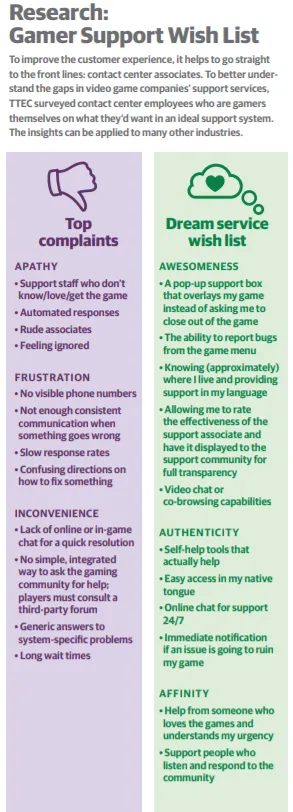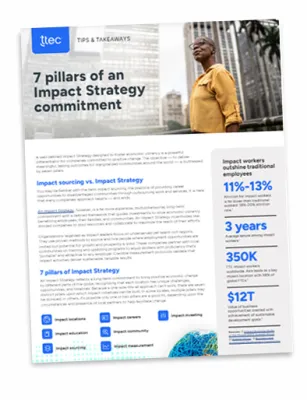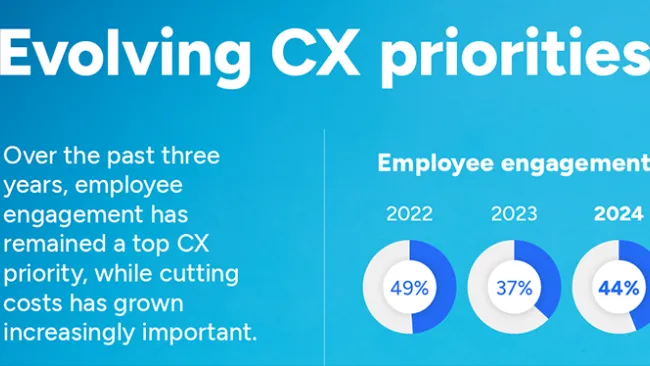Customers who need help have a simple request. They want their problems solved quickly within their preferred channel and language. And they want their interactions to be proactive, engaging, and frictionless. Businesses that are focused on the customer experience as a competitive advantage are listening and are rethinking the role contact centers play, along with the teams and technologies needed to support them.
Organizations are increasingly using contact centers as a resource to improve customer relationships more than to support business growth. In fact, according to Deloitte’s 2017 Global Contact Center survey, 88 percent of respondents indicated that “customer experience and expectations” was a main driver of growth in the contact center, up from 71 percent in 2015. By contrast, 43 percent indicated “growth of business” was a main driver, down from 78 percent in 2015.
Better customer experiences begin with supporting employees. Here are 11 innovations in customer support that can help companies gain a competitive edge with a prepared and motivated staff.
1. Recruit brand ambassadors
Go beyond general job sites to find and recruit passionate users from online communities and niche social networks. Customers can refer other dedicated customers as well.
A tailored screening process is also important. For example, support candidates for a video game company could be pre-screened based on their game preferences and have their game-playing skills and personality assessed by gamers and behavioral scientists, as well as the gaming community at-large.
2. Train quickly and effectively with a tailored onboarding program
An immersive and specific onboarding program will prepare new hires to support customers faster than a generic onboarding program. For instance, by leveraging technology, discovery learning concepts, and RealPlay simulated learning, new hires get a hands-on learning experience that prepares them to offer knowledgeable support.
3. Enhance the workday with apps
Employees could use an app to manage aspects of their job, from scheduling to compensation. For example, the app can alert staff of volume spikes, with offers for employees to work on short notice or even take calls via the app. If a widespread problem occurs with a newly released product, for instance, associates could quickly go online to provide support and keep wait times down. Another tab on the app would let associates review their work hours and paychecks.
The app could also include forecasting technology that helps contact center leaders make fast and accurate decisions about staffing levels.
4. Call out sick with a chatbot
When employees are too sick to work, schedules can be disrupted, leading to an adverse effect on service quality. Instead of scrambling to fill the gaps, an AI chatbot can streamline the scheduling process. Employees, for example, could interact with a chatbot on their phones to call out sick and get the information into the workforce management system immediately.
The bot would send a message to a manager to adjust the employee’s schedule. Or taking automation a step further, it could automatically fill vacant shifts based on organizational requirements, let employees swap shifts, and notify the employer and employee of any payroll changes.
5. Bulk up on resources
Keep the knowledgebase fresh by encouraging all support staff to submit content to it and reward them for the contribution. Associates earn badges and certifications based on their contributions, which are visible to customers as well. The badges could also be used to earn specific rewards like branded merchandise and access to beta testing and/or early release huddles/parties/testing.

6. Leverage employee data
Employee data that’s automatically collected can be analyzed to produce productivity dashboards, providing real-time information and insights on an employee’s support performance. The reports can then isolate and identify specific problems and assist with creating a culture of accountability. At the same time, employees can track their performance as they compete for badges and other perks through gamified performance monitoring.
7. Match customers with associates, “Tinder-style”
Instead of being assigned to an anonymous support team member, it would be far more engaging if customers could swipe right or left on the associate whose expertise best matches their needs. For example, employees at an outdoor sports and apparel company could have profiles listing their favorite sports, hiking spots, camping style, etc. Employees would also have to sign into the app to ensure that they’re available to provide assistance.
8. Identify fans who are also support staff
Allow staff members to identify themselves as employees who can provide real-time support when they’re using the company’s product. Employees for a photography store, for example, could host outings and offer advice on how to best use the camera equipment while taking photos themselves.
Brand ambassadors would also have the satisfaction of helping customers while doing what they enjoy.
9. Reimagine workspaces
In order to offer expert support, employees need optimal environments to test and experience the company’s products and discuss strategies. Gamers, for instance, need collaborative gaming environments and community-oriented spaces to share ideas. An ideal gaming environment could be lounges stocked with games to provide exposure to gamer experts and facilitators, as well as tools to shore up the associate’s personal gaming preferences and experience.
Other employees may prefer traditional cubicles. Customer support leaders should reassess their contact centers to make sure they’re optimized for their staff’s needs.
10. Provide global support
Especially at global companies, customers demand support at any time, and want to communicate in a variety of languages. The associates supporting them must be able to meet those expectations. A hybrid approach of in-office and at-home players who can write, read, and speak different languages would enable companies to engage customers anytime, anywhere. At-home associates can also handle peak period surges on an as-needed basis, thereby easily supporting peak demand without having resources in place that are underutilized.
11. Give staff members a reason to get excited
While competitive compensation and benefits remain central to acquiring and retaining the best player support team members, consider additional incentives that will motivate employees while limiting out-of-pocket costs. Those incentives could include:
- Early access to new releases or product rollouts
- Opportunities to earn free merchandise
- Opportunities to invite family and friends to corporate-sponsored events
- Gift cards or other perks to reward support team members for a star rating
- A community badge with tiered recognition
Even if you can’t implement all 11 points, the important thing to remember is that customers aren’t the only ones who need support. Employees also thrive in an environment that understands and values their needs. And underneath the rapid advancements in technology, the same adage holds true: happy employees equal happy customers.

















